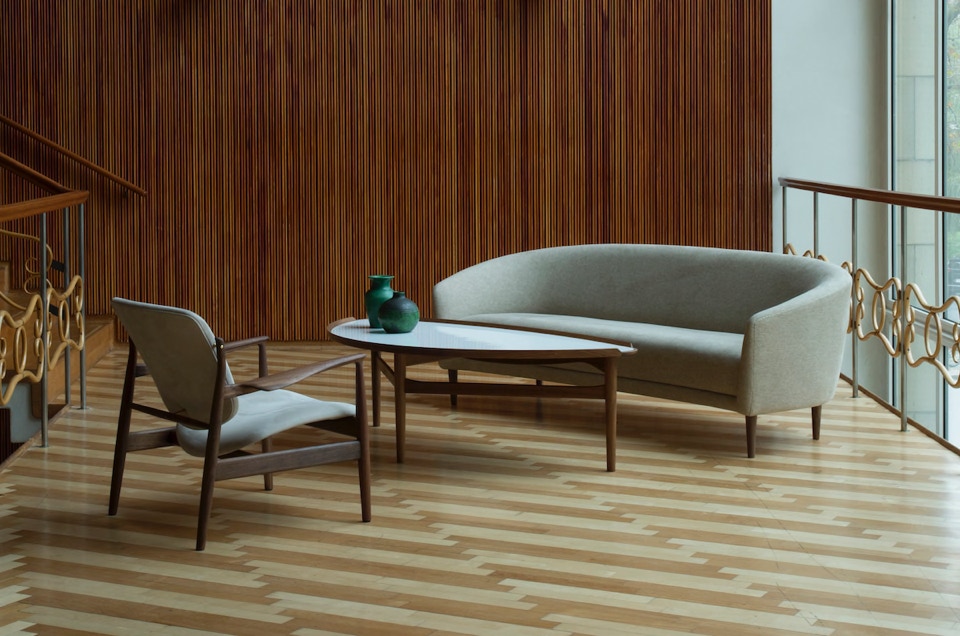15% off with DESIGN15

The Little Mother Sofa introduce us into the tale of a romantic Danish poet and his wife. They lived in a small farmhouse, decorated with a sofa designed by Finn Juhl. This stage became a staple of Danish folk culture through the comic strip “The Poet and the Little Mother” by Jørgen Mogensen, which was published in Politiken on a daily basis from 1950 to 2003. This makes it nothing short of the world’s longest lasting comic strip!
The story goes: master joiner Niels Vodder, who produced Finn Juhl’s furniture, gifted his daughter Kirsten the prototype of a small sofa in 1945. Kirsten Vodder was married to the poet Frank Jæger, whose favorite activity was to lie on the sofa and ponder the events of life. The close friend of the family and illustrator Jørgen Mogensen would spend a lot of time at their house, which eventually inspired the comic strip.
The “Little Mother” sofa comes in two lengths and presents itself as a seamless design with a slight and natural curvature towards the center. The organic shape and tight upholstery nicely accentuate the sculptural expression of the sofa. Its shape embraces the seated body, making it comfortable in any position. There are no sharp edges against the body, just soft rounded shapes that will lightly give in.
The “Little Mother” sofa is entirely handcrafted, down to the smallest detail. It is constructed in an old-fashioned manner consisting of a solid blind frame and handsewn upholstery. We are very much looking forward to adding another piece to our Finn Juhl range, even more so one that has been in hibernation since 1945. Today, 75 years later, the “Little Mother” sofa is just as relevant in decorating a home as it is in an elegant hotel lobby.
Legs oak, walnut or black
Upholstery fabric
Seat height 41 cm – Total height 78 cm – Depth 86 cm – Length 136 ou 216 cm
2-seater – W136 cm
from
3-seater – W216 cm
from









oak
walnut
black
Examples:
Hallingdal 100 (fabric price group 2) / Oak
Hallingdal 100 (fabric price group 2) / Walnut
Hallingdal 103 (fabric price group 2) / Walnut
Hallingdal 103 (fabric price group 2) / Oak
Watercolour Butterscotch (fabric price group 3) / Walnut
Watercolour Cast Iron (fabric price group 3) / Walnut
Watercolour Dark Conifer (fabric price group 3) / Oak
Watercolour Fresh Sage (fabric price group 3) / Oak
Watercolour Golden Syrup (fabric price group 3) / Walnut
Watercolour Himalaya (fabric price group 3) / Oak
Watercolour Peacock (fabric price group 3) / Oak
Watercolour Pumpkin Spice (fabric price group 3) / Walnut
Watercolour Rose Quartz (fabric price group 3) / Walnut
Watercolour Silver Azure (fabric price group 3) / Oak
Watercolour Soft Linen (fabric price group 3) / Walnut
Remix 0123 (fabric price group 1) / Wanut
Remix 163 (fabric price group 1) / Oak
Remix 183 (fabric price group 1) / Oak
Remix 242 (fabric price group 1) / Walnut
Remix 412 (fabric price group 1) / Walnut
Remix 443 (fabric price group 1) / Oak
Remix 612 (fabric price group 1) / Oak
Remix 762 (fabric price group 1) / Walnut
Remix 823 (fabric price group 1) / Walnut
Remix 933 (fabric price group 1) / Oak
Hallingdal 113 (fabric price group 2) / Walnut
Hallingdal 110 (fabric price group 2) / Walnut
Hallingdal 227 (fabric price group 2) / Oak
Hallingdal 376 (fabric price group 2) / Walnut
Hallingdal 457 (fabric price group 2) / Walnut
Hallingdal 764 (fabric price group 2) / Oak
Hallingdal 960 (fabric price group 2) / Oak
Hallingdal 960 (fabric price group 2) / Walnut
Vidar 152 (fabric price group 4) / Walnut
Vidar 182 (fabric price group 4) / Walnut
Vidar 222 (fabric price group 4) / Oak
Vidar 443 (fabric price group 4) / Oak
Vidar 472 (fabric price group 4) / Walnut
Vidar 582 (fabric price group 4) / Walnut
Vidar 633 (fabric price group 4) / Oak
Vidar 723 (fabric price group 4) / Walnut
Vidar 1062 (fabric price group 4) / Oak
Vidar 1511 (fabric price group 4) / Oak
Finn Juhl

As a teenager, Finn Juhl (1912-1989) wanted to become an art historian, having a passion for the fine arts since childhood. His father stopped him and Finn Juhl started architectural studies. Later, when his fame as a designer of furniture acquired, he speaks of himself as an autodidact, in reference to this upset vocation that forced him to walk intellectually on a lonely way. His style owes much to this singular trajectory, with its non academic interpretation of art visible in his work. Finn Juhl started his studies in 1930, a key period which saw the birth of modern design and furniture.
His modern offices in central Copenhagen was greeting his visitors with a huge Japanese fish in paper, symbol of imagination. Rather than thinking in terms of practical construction, Finn Juhl had the mind-set of a sculptor, when he shaped a piece of furniture. In the 1940s and 1950s, this way of working had never been seen before. His ambition was to design furniture with movement and life.
Juhl took pride in making both the structurally supportive elements of the furniture and the seated person look as though they are floating. In some of his chairs, the backrest and the seat are almost invisibly joined, as if they were clouds floating through the room.
In creating his furniture, Finn Juhl worked with two elements: The carrying element, and the carried. He eventually became known for his special ability to separate the bearing parts from the borne. This is one of many examples of how he broke free from conventional working methods and found his inspiration in art.